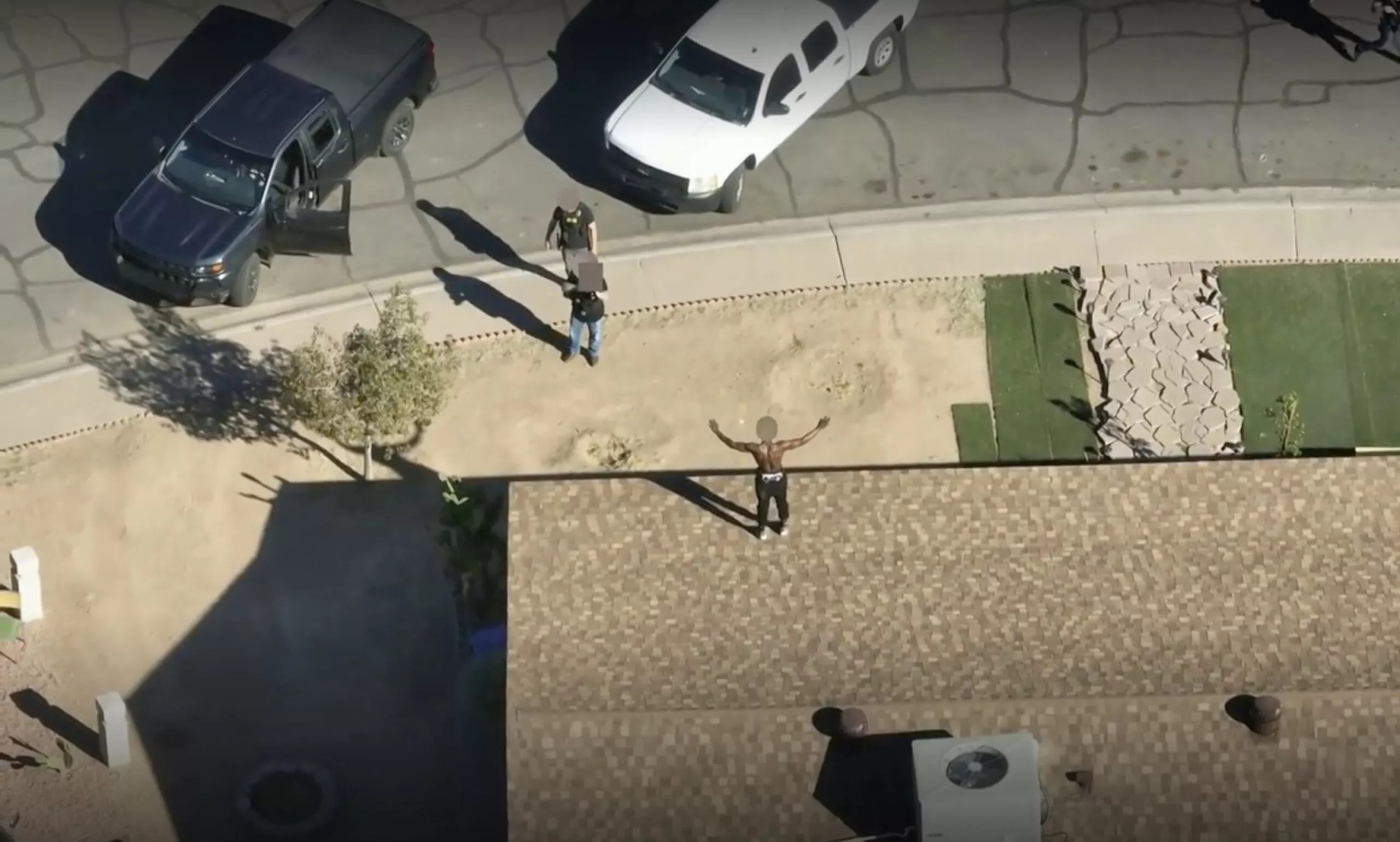
Courtesy of the Clay family

Audio By Carbonatix
In January, 33-year-old Turrell Clay died not long after being arrested by Phoenix police. An autopsy report released on Aug. 8 – seven months after Clay’s death – pins the blame on the supposedly “less-lethal” weapons that police used to subdue him.
Clay was arrested on Jan. 10 after police pursued him through a Maryvale neighborhood because of an outstanding parole violation. He eventually settled on the roof of a home and refused to come down, leading several officers to fire weapons that launch 37-millimeter plastic batons meant to obtain “pain compliance.” Clay was eventually pulled off the roof, dogpiled by cops and handcuffed.
Paramedics from the Phoenix Fire Department checked Clay’s vitals and cleared him at the scene, according to the autopsy report, but Clay began complaining of chest pains while being transported in the back of a police vehicle. He was driven to a hospital, where he told doctors that the pain felt “like a tank on his chest.” Hours after he was arrested, he died while doctors were attempting a surgical procedure to save his life.
The cause of Clay’s death was mysterious at the time, though the autopsy report – prepared and signed by Maricopa County Medical Examiner Colleen Klein and forensic pathology fellow Kapitolina Semenova – left little open to interpretation. Clay had three visible injuries from the “less-lethal” batons on his body, including one over his heart, though the autopsy noted those injuries were covered in dirt and could have been missed at the scene. He also had internal bleeding and damage to a lung.
Phoenix, make your New Year’s Resolution Count!
We’re $14,000 away from our End-of-Year campaign goal, with just a five days left! We’re ready to deliver — but we need the resources to do it right. If New Times matters to you, please contribute today to help us expand our current events coverage when it’s needed most.
The report listed Clay’s death as a homicide caused by “blunt force trauma to the chest” due to being “struck in the chest by less lethal ammunition.”
“Depending on their design and velocity, less-lethal munitions can deliver substantial blunt force impact,” the autopsy report says. “Although classified as ‘less-lethal,’ these munitions carry the potential for serious injury or death, particularly when impacting vulnerable regions of the body.”
On July 9 – before the autopsy was released – Clay’s family filed a notice of claim seeking $15 million from the city of Phoenix for his death. An attorney for Clay’s family did not return phone calls from Phoenix New Times.
The autopsy report extensively details the damage the less-lethal batons did to Clay’s body. Officers fired seven of the less-lethal munitions at Clay, though it is unclear exactly how many of them hit. Clay suffered three injuries from the munitions – on his right thigh, left arm and the left side of his chest. Underneath one welt from the baton, there was heavy bleeding. Two of Clay’s ribs were also broken.
The autopsy found evidence of a transmural myocardial infarction – a severe heart attack – as well as a tear through the membrane around Clay’s heart and bleeding through the heart wall. Clay also suffered internal bleeding: 600 milliliters of blood (the equivalent of 2.5 cups) were recovered from Clay’s left chest cavity, and 400 milliliters were recovered from the sac around his heart.
According to the report, methamphetamine was detected in Clay’s system, though the report states that “the visible laceration/contusion of the heart is the far more likely” cause of Clay’s heart attack. The report also says that Clay’s fall from the roof “could have also contributed to the severity of chest trauma initiated by the less-lethal ammunition strike.”

Phoenix police officers aim their weapons at Turrell Clay as he stands on a rooftop with his arms raised in surrender in Maryvale on Jan. 10.
Phoenix Police Department
Less lethal?
Clay’s death may be the first caused by the 37-millimeter less-lethal launchers since the Phoenix Police Department began using them four years ago.
In 2021, the department began a pilot program to use the weapons with the goal of reducing officer shootings. The launchers have been touted by the department as a less violent way to bring people into police custody. The department uses launchers that fire cylindrical 37-millimeter batons – which killed Clay – and 40-millimeter batons.
Phoenix police’s policy for the 37-millimeter batons – which are used only by the department’s tactical teams – has not been made public. But the manufacturer of the launchers, Sage Control Ordnance, specifies that shots to the heart can cause “death or serious injury.” The department’s police for the 40-millimeter launchers is public and recommends a firing distance of between 15 and 105 feet. According to the autopsy report, officers fired at Clay from between 30 and 90 feet away, suggesting the weapons can be lethal even when used within policy.
Phoenix police have faced criticism and legal action for the use of some “less-lethal” weapons before. A 2022 lawsuit and the 2024 Department of Justice investigation condemned the department’s use of pepper balls, tear gas and pepper spray. The use of these “less-lethal” launchers against civilians in tactical situations is less documented, but available evidence suggests they are not working to reduce the use of force by police.
Clay’s death was one of the subjects of an investigation by the Howard Center for Investigative Journalism at Arizona State University, which found that the Phoenix police’s use of the launchers has not reduced the number of officer shootings. Notably, though, the opacity of the department’s use-of-force data makes it hard to determine if other deaths have been caused by the less-lethal launchers.
The department keeps a database of use-of-force incidents, but it does not publicize in its data whether either kind of launcher has caused a death. A Phoenix police spokesperson was not able to confirm with New Times whether the 37-millimeter launchers have caused any deaths.
Jared Keenan, the legal director for the Arizona branch of the ACLU, said that the department’s promotion of the launchers may lead some officers to underestimate their power. Keenan is not involved with Clay’s wrongful death case.
“When you are told, either implicitly or explicitly, that these types of weapons are less lethal, you’re sort of implicitly told that they’re safe, right?” Keenan said. “I think that encourages officers to use them more often than they should.”
The three officers who fired the launchers at Clay were cleared of wrongdoing by the Gila County Attorney’s Office, which found they acted within department policy. The Maricopa County Attorney’s Office passed the case off due to a “conflict,” according to a letter obtained by New Times from Gila County Attorney Brad Beauchamp. Representatives from the two offices would not confirm with New Times the nature of the conflict.
In a written statement, Phoenix police communications director Donna Rossi said Clay’s death “remains the subject of an administrative investigation as well as the subject of litigation.”
In light of the autopsy report’s finding that the launcher munitions caused Clay’s death, New Times asked Phoenix police if the department has adjusted or plans to adjust its guidance for the weapons’ use. The department did not respond to that and other questions.
Keenan said that the possibility of reform in the department after this case is small, to say the least.
“A department that was self-reflective and desired to reform and change the way it interacts with the public might take this as an opportunity to make necessary changes and prohibit the use of, or the overuse of, these types of weapons,” Keenan said. “I do not foresee that being the case in the city of Phoenix.”